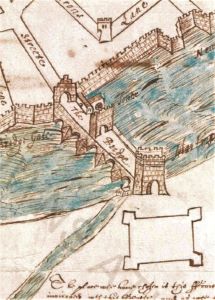THE WEST BRIDGE, A BRIEF HISTORY OF THE EARLY YEARS

by Tom Kenny
The City of Galway was known in ancient times as ‘Streamstown’ because the Galway River divided into several small waterways in addition to the main river. The river was much more spread out then and was fordable in some places. The city was placed on the east side of the river which acted as protection against the Irish families displaced by the Norman settlers who took over the area in the early 13th century. The walls of the city provided protection on the east and north side of the city and the various gates allowed access. The river was a barrier to trade with Iar-Chonnacht and so the merchant families began to feel the need to build a bridge to help expand trade, it would provide access to customers from the west, and also allow them to bring in their produce, fruit, vegetables, meat, hay etc. to the various markets in town.
In 1342, the West Bridge was constructed, under the direction of Edmund Lynch, on the site where people previously used to ford the river. It was an opening to the west, the focal point of all routes leading from the west and northwest but, for fear of attack from that quarter, it was even more heavily fortified than the other entrances through the city walls. The earliest illustration of the bridge we know of is a detail from a 1583 map by Barnaby Gooche (figure A) which shows the very strong fortified gateway on the eastern side. On September 13th 1558, Thomas Martin was given permission to build what we now know as the Bridge Mills on condition that he build a similar gate (not shown on the Gooche map) on the western side.

Some 40 years later, it was depicted on a 1627 map (figure B) as having fortified walls at each end and a third one in the middle. There is a legend that one of these arches carried the inscription “From the Ferocious O’Flaherties, Good Lord deliver us”, but there is no proof of this. Our third drawing (figure C) is from the 1651 map and is a more elaborate representation of the three fortified gates on the bridge.


Our main illustration (figure D) is a profile of the bridge taken from Thomas Phillips “Prospect of Galway" drawn in 1685 and shows us that part of the western gate is still intact, but the other two have been demolished. It seems the threat from the ferocious O'Flaherties and others had receded. The bridge had nine arches and the centre looks quite precarious. It also shows the river as being much wider and shallower then and not having the same powerful current as it does today. The section on the left shows part of what we now know as Lower Dominick Street, and the bridge on the far left was then called An Droichead Maol, or Bald Bridge indicating that it did not have any parapets. In the 18th century, it became known as Balls Bridge and as you can see, had a significant flow of water which was altered in 1851 when the canal was built and the bridge became a swivel bridge.

More next week.
.png)